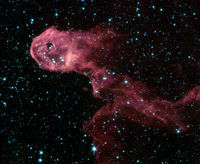Elephant's Trunk nebula
| Elephant's Trunk nebula | |
|---|---|

| |
| Observational Data | |
| Designation | vdB 142 |
| Right ascension | 21h 39m[1] |
| Declination | +57° 29′ 24″[1] |
| Constellation | Cepheus |
| Type of object | Emission nebula |
| Astrometry | |
| Distance from Earth | 2,450 ly[2] |
| Radial velocity | -15.35±3.41 km/s[1] |
| Proper motion | RA: -2.30 mas/yr[1] Dec.: -3.81 mas/yr[1] |
The Elephant's Trunk nebula (vdB 142, sometimes designated IC 1396A) is part of the emission nebula and star cluster that is IC 1396 complex.[3] The IC 1396 complex is itself a huge nebula covering around 5° of the night sky. Located in the constellation of Cepheus, the nebula is a dense conglomeration of gas and dust that is being compressed the radiation and stellar winds of nearby stars.[2] These winds sculpt the nebula and are responsible for the circular rim (head) and long gas tail (trunk) of the nebula. The "trunk" which is around 20 light years long.[3]
The Spitzer Space Telescope has imaged the IC 1396 complex in the infrared portion of the electromagnetic spectrum.[4] The obscuring effects of dust are not a problem in the infrared, meaning Spitzer has observed many otherwise invisible stars. A pair of stars (designated LkHa 349 and LkHa 349c) are responsible for the hole in the "head" of the nebula. LkHa 349c is much dimmer than LkHa 349 in visible light but they are of similar brightness in the infrared and so was observed by Spitzer. As they are both of similar brightness in the infrared, it is believed that LkHa 349c is surrounded by a large amount of dust.[2]
References
- ↑ 1.0 1.1 1.2 1.3 1.4 IC 1396 from the SIMBAD Astronomical Database. Using parameters of the star cluster.
- ↑ 2.0 2.1 2.2 The Elephant's Trunk nebula (PDF document) from coolcosmos.ipac.caltech.edu
- ↑ 3.0 3.1 The Elephant's Trunk Nebula in Cepheus from apod.nasa.gov
- ↑ Dark Globule in IC 1396 from spitzer.caltech.edu